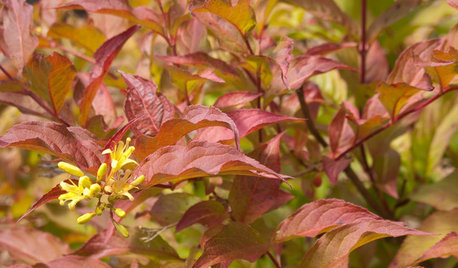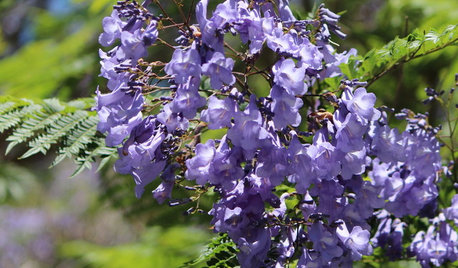[images] Beautiful and fragrant - Chinaberry trees.
snasxs
15 years ago
Related Stories

GARDENING GUIDES8 Plants for a Deliciously Fragrant Fall Garden
Scent the autumn air with the perfume of caramel corn, honey and spices by adding these intoxicating plants to your landscape
Full Story
GARDENING GUIDESGreat Design Plant: Northern Bush Honeysuckle, a Bronze Beauty
It helps control erosion and takes sun or shade. The butterflies love it. But the best part of this shrub may be the vivid foliage
Full Story
GARDENING AND LANDSCAPINGSteeply Beautiful Slope Retention
Don't let things slide or give in to sandbags and cement. These slope retention ideas will keep your landscape hitting the high notes
Full Story
ECLECTIC HOMESMy Houzz: A Treehouse-Like Dwelling in Los Angeles
Fragrant breezes, chirping birds and glorious sunsets provide a beautiful live-work setting for this design couple and their kids
Full Story
GARDENING GUIDESHouzz Call: What’s Your Favorite Backyard Beauty?
The simple, honest daisy is this writer’s go-to garden flower. We want to hear which plant, flowering or otherwise, gives you special joy
Full Story
HOLIDAYSWinter Makeover: Naturally Beautiful Christmas Décor
Go green and easy with evergreen garlands, swags and centerpieces
Full Story
PLANTING IDEASGreat Garden Combo: 9 Plants for an Intriguing Entrance
Layer trees, flowers and shrubs around an archway to create the feeling of a year-round doorway to adventure
Full Story
SPRING GARDENINGTop 10 Scented Plants for Your Garden
A palette of perfumed plants can transform even the smallest of gardens into a sensory delight
Full Story
CALIFORNIA GARDENINGCalifornia Gardener's July Checklist
Bite into tree-fresh apricots, inhale delightful garden perfumes and continue planting vegetables for a late-summer harvest
Full Story
GARDENING FOR BIRDSFeed the Birds: 6 Plants for Abundant Winter Berries
Be kind to your fair feathered friends during lean food times by planting a shrub or tree loaded with nutritious snacks
Full StorySponsored
Franklin County's Custom Kitchen & Bath Designs for Everyday Living
More Discussions








pineresin
Iris GW
Related Professionals
Forest Park Landscape Architects & Landscape Designers · Jennings Landscape Architects & Landscape Designers · Seabrook Landscape Architects & Landscape Designers · Barrington Landscape Contractors · Gaithersburg Landscape Contractors · Mendota Heights Landscape Contractors · Middletown Landscape Contractors · Oxnard Landscape Contractors · Rio Linda Landscape Contractors · West Orange Landscape Contractors · Ashburn Decks, Patios & Outdoor Enclosures · Bonita Decks, Patios & Outdoor Enclosures · Lansdale Decks, Patios & Outdoor Enclosures · Wildomar Decks, Patios & Outdoor Enclosures · Canyon Lake Stone, Pavers & Concretearktrees
snasxsOriginal Author
Embothrium
snasxsOriginal Author
arktrees
turbo_tpl
cjra
Fledgeling_
snasxsOriginal Author
Fledgeling_
Fledgeling_
snasxsOriginal Author
pineresin
david_
alabamatreehugger 8b SW Alabama
snasxsOriginal Author
treeguy123
Iris GW
snasxsOriginal Author
Iris GW
treeguy123
snasxsOriginal Author
treeguy123
arktrees
Embothrium
Embothrium